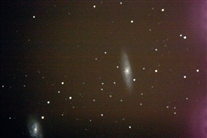m066_1600iso_300sec_f065_9.jpg
Messier 66 - Spiral Galaxy (NGC 3627), type Sb, in Leo
LX200GPS 12" f/6.5 (Tracker3). 5min unguided with Canon 300d at 1600iso. Taken at Hildebrandt Ranch. These two galaxies are two of the galaxies that make up the Leo Triplet.
Right Ascension 11 : 20.2 (h:m)
Declination +12 : 59 (deg:m)
Distance 35000 (kly)
Visual Brightness 8.9 (mag)
Apparent Dimension 8x2.5 (arc min)
Discovered 1780 by Charles Messier.
Excerpt from seds.org:
Messier 66 (M66, NGC 3627), together with its neighbors M65 and NGC 3628, forms a most conspicuous triplet of galaxies, the Leo Triplett or M66 group, located at a distance of about 35 million light years.
M66 is considerably larger than its neighbor, M65, and has a well developed but not well defined central bulge, and is therefore classified Sb. Obviously its spiral arms are deformed, probably because of the encounters with its neighbors. They seem to be distorted and displaced above the plane of the galaxy. Note how one of the spiral arms seems to pass over the left side of the central bulge. Much dust is visible here, as well as a few pink nebulae, signs of star formation, near the end of one of the arms.
This image was obtained by David Malin with the 3.9-meter Anglo Australian Telescope; interested readers may obtain more detailed information on this image.
Together with its neighbor M65, M66 has been discovered by Charles Messier, who cataloged it on March 1, 1780, remarks that he missed these two objects in 1773, when a comet passed between them on November 1 to 2, 1773, probably because of the light of the comet. Because of a dubious error, Admiral Smyth has assigned this discovery of M65 and M66 (and M68) to Pierre Méchain, a view which was adopted by Kenneth Glyn Jones somewhen in the 1960s, and consequently, in many modern sources, despite the fact that Messier doesn't acknowledge such a prior sighting, which he did in all other cases.
Three supernovae have appeared in this galaxy:
1973R which was of type II and reached mag 15 was found on Dec 12, 1973.
1989B was discovered on Jan 31, 1989 and became as bright as mag 12.2 on Feb 1, 1989.
1997bs was discovered by the Lick Observatory Supernova Search Team as it occurred on April 15, 1997 at 13" west, 67" south of the galaxy's center and reached mag 17.0; this was of peculiar type IIn.
Halton Arp has included M66 in his Catalogue of Peculiar Galaxies as entry No. 16. Moreover, he assigned the number 317 to the Leo Triplett (M66 together with M65 and NGC 3628).
